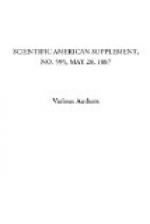I place a glass cell containing water in front of the slit, and on the screen I throw a patch of blue light. I now change it for turbid water in a cell. This thickness much dims the blue; with a still greater thickness the blue has almost gone. If I measure the intensity of the light at each operation, I shall find that it diminishes according to a certain law, which is of the same nature as the law of absorption. For instance, if one inch diminishes the light one half, the next will diminish it half of that again, the next half of that again, while the fourth inch will cause a final diminution of the total light of one sixteenth. If the first inch allows only one quarter of the light, the next will only allow one sixteenth, and the fourth inch will only permit 1/256 part to pass.
Let us, however, take a red patch of light and examine it in the same way. We shall find that, when the greater thickness of the turbid medium we used when examining the blue patch of light is placed in front of the slit, much more of this light is allowed to pass than of the blue. If we measure the light, we shall find that the same law holds good as before, but that the proportion which passes is invariably greater with the red than the blue. The question then presents itself: Is there any connection between the amounts of the red and the blue which pass?
Lord Rayleigh, some years ago, made a theoretical investigation of the subject. But, as far as I am aware, no definite experimental proof of the truth of the theory was made till it was tested last year by General Festing and myself. His law was that for any ray, and through the same thickness, the light transmitted varied inversely as the fourth power of the wave length. The wave length 6,000 lies in the red, and the wave length 4,000 in the violet. Now 6,000 is to 4,000 as 3 to 2, and the fourth powers of these wave lengths are as 81 to 16, or as about 5 to 1. If, then, the four inches of our turbid medium allowed three quarters of this particular red ray to be transmitted, they would only allow (3/4)^{5}, or rather less than one fourth, of the blue ray to pass.
Now, this law is not like the law of absorption for ordinary absorbing media, such as colored glass for instance, because here we have an increased loss of light running from the red to the blue, and it matters not how the medium is made turbid, whether by varnish, suspended sulphur, or what not. It holds in every case, so long as the particles which make the medium turbid are small enough. And please to recollect that it matters not in the least whether the medium which is rendered turbid is solid, liquid, or air. Sulphur is yellow in mass, and mastic varnish is nearly white, while tobacco smoke when condensed is black, and very minute particles of water are colorless; it matters not what the color is, the loss of light is always the same. The result is simply due to the scattering of light by fine particles,




